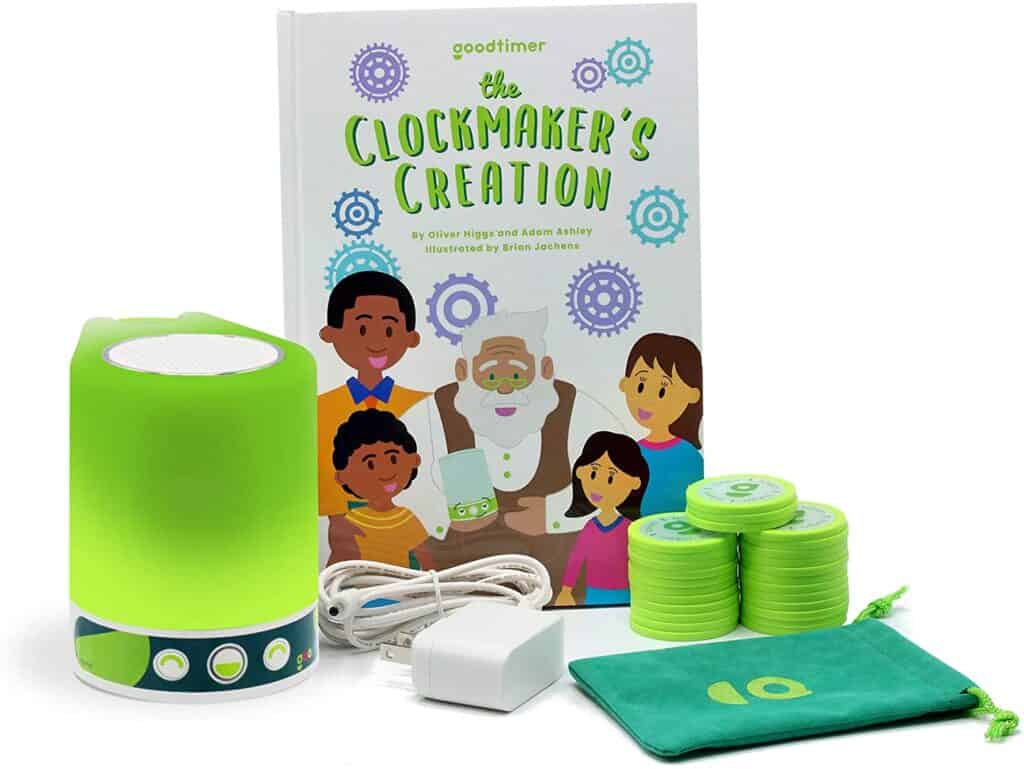Easy Steps to Improve Your Child’s Behavior with Goodtimer
Many parents, even seasoned ones, struggle with ways to improve their child’s behavior. Punishments, rewards, consequences, time-outs, time-ins — sometimes we wonder why it’s so difficult to find something that works! Luckily I’ve discovered Goodtimer and I can share these easy steps to improve your child’s behavior today.
Read on to see how Goodtimer works to increase healthy habits and decrease challenging behaviors, and how it resulted in less yelling and a peaceful home for our family.
This post may contain affiliate links. If you make a purchase, I may earn a small commission at no extra cost to you. As an Amazon Associate, I earn from qualifying purchases. Read more about these links in my disclosure policy.
What is Goodtimer?
Goodtimer is an interactive gadget that encourages children to develop good habits by providing positive behavior reinforcement. Created by parents and backed by neuroscience, Goodtimer helps to remove the frustration and guilt of behavior management by promoting patterns of good behavior.
Goodtimer was developed when Adam Ashley, a normal dad with kids who misbehave on occasion, realized that yelling and timeouts weren’t working for his kids… or for him and his wife. Wanting a better solution, they turned to experts and began to research other options.
After trying different variations of positive parenting methods, they came up with the idea to make a game out of earning points for good behavior. From there, their idea evolved into finding a way to encourage positive behaviors by rewarding it, rather than punishing the bad behavior. Thus, Goodtimer was born – the solution to the “opposite of timeout.”
How does Goodtimer work?
The basic concept of Goodtimer is for your child to earn “Good Time” by following your family’s established set of age-appropriate rules. As long as your child is behaving appropriately, Goodtimer stands right side up and accumulates “Good Time.” After your child has earned enough good time and the device becomes fully lit, Goodtimer plays a notification – using green lights for visual cues – that your child has earned a token, which can be redeemed for a reward.
As the Goodtimer accumulates time in twelve segments – just like a clock – the device adds more and more green glowing light. Occasionally, Goodtimer will provide positive verbal encouragement to let your child know they are doing a great job.
If your child breaks a rule or begins to show undesirable behavior, you simply turn Goodtimer over. It plays a bit of a sad melody and stops glowing and accumulating Good Time. Once your child begins demonstrating good behavior again, you turn Goodtimer right side up and the positive reinforcement resumes.
Goodtimer is designed to work best for children ages 3-10, but depending on your child, you may find success slightly outside of this age range.
It does require entire family participation to stay consistent for positive outcomes, but with constant positive reinforcement you really can see better behavior pretty quickly!
This video shows how the Williams family uses Goodtimer for positive behavior management in their home:
How do you start using Goodtimer?
Included with Goodtimer is a book called The Clockmaker’s Creation. It is an engaging story and a fun read that explains what Goodtimer is about and how it works.
After reading the book, parents and children sit down to create a list of house rules. It’s important to involve your child in this step, as it gives them a sense of “ownership” and say in the family’s house rules.
Parents and children also work together to develop a list of fun incentives to reward the good choices. (Be sure to check out our sample incentive chart at the bottom of this post!)
Once the rules and rewards are established, it’s time to turn on Goodtimer and get started!
What is included with Goodtimer?
In addition to the Goodtimer device, the package includes a charging cable (the Goodtimer has a built-in rechargeable battery that lasts 4-5 days), the hardcover book, 32 reusable tokens, and a plush token pouch to hold extra tokens.
Parents who purchase Goodtimer also have access to a private Facebook group for additional support from Goodtimer experts and other parents!
My honest Goodtimer review
My initial thoughts
As a mom of four children whose ages range from 2 to 19 years old, you might think I have all of these behavior concerns figured out by now. Especially if you know that I have 12 years experience teaching special education, plus two master’s degrees in education. I should be a pro at behavior management strategies, right?
Well… you’d be wrong. Because I most certainly do NOT have all the answers.
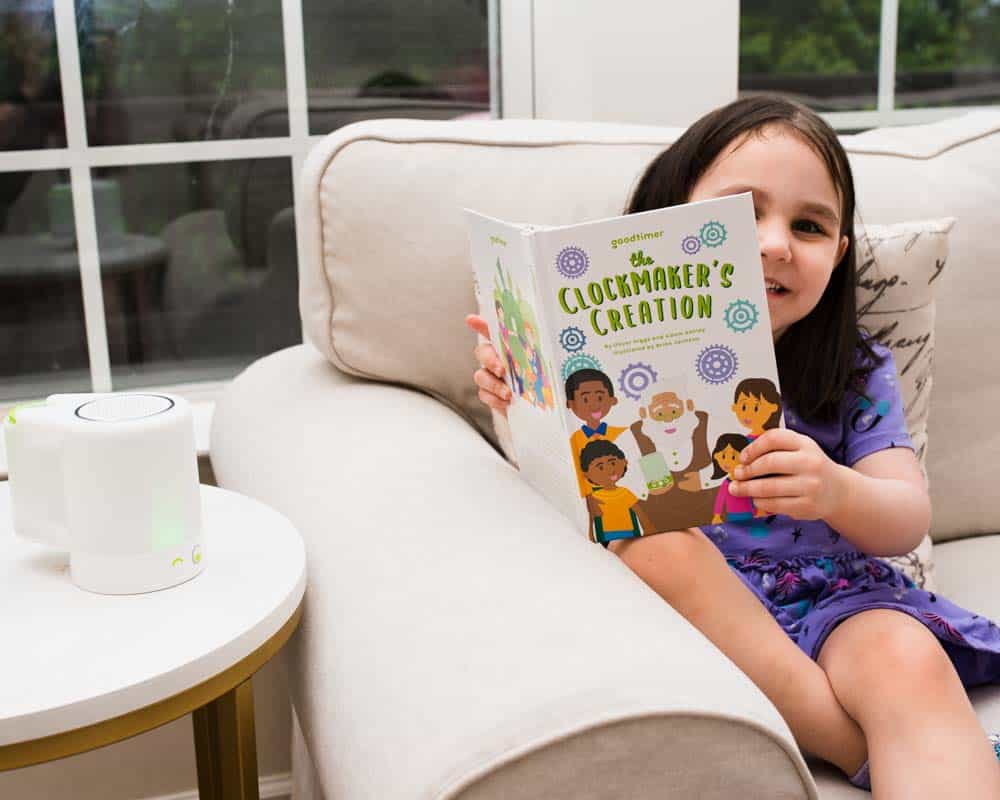
One thing I have learned over the years is that every child is different, and what works for some children does not always work for others. I had tried various reward systems for my kids at home. Yet so far with my 2 and 3 year olds, I had not found a method that was consistently effective.
So I hope that you understand when I say I was skeptical of Goodtimer. I thought to myself, “What is this? With all the research out there, how is this new contraption going to actually work? I don’t have time to waste trying to figure out another new method.”
And I wasn’t going to try it at all. Except… I was tired of yelling. I was tired of being frustrated. It seemed like maybe I should just try it and see.
We got the box in the mail and I introduced Goodtimer to my 3 year old daughter. We read the book together (I had to paraphrase a few parts so she wouldn’t lose interest) and we talked about using Goodtimer in our home.
Then I forgot about it for a few days because I was busy. Guess who didn’t forget? My daughter.
Getting started
After a quick refresher on how Goodtimer worked, we set up our rules and our rewards. That part was pretty easy since we had previously been using a sticker chart to reward good behaviors.
Man was I glad to let that sticker chart go! It lost its effectiveness when I would forget to give stickers right away – which usually happened at bedtime.
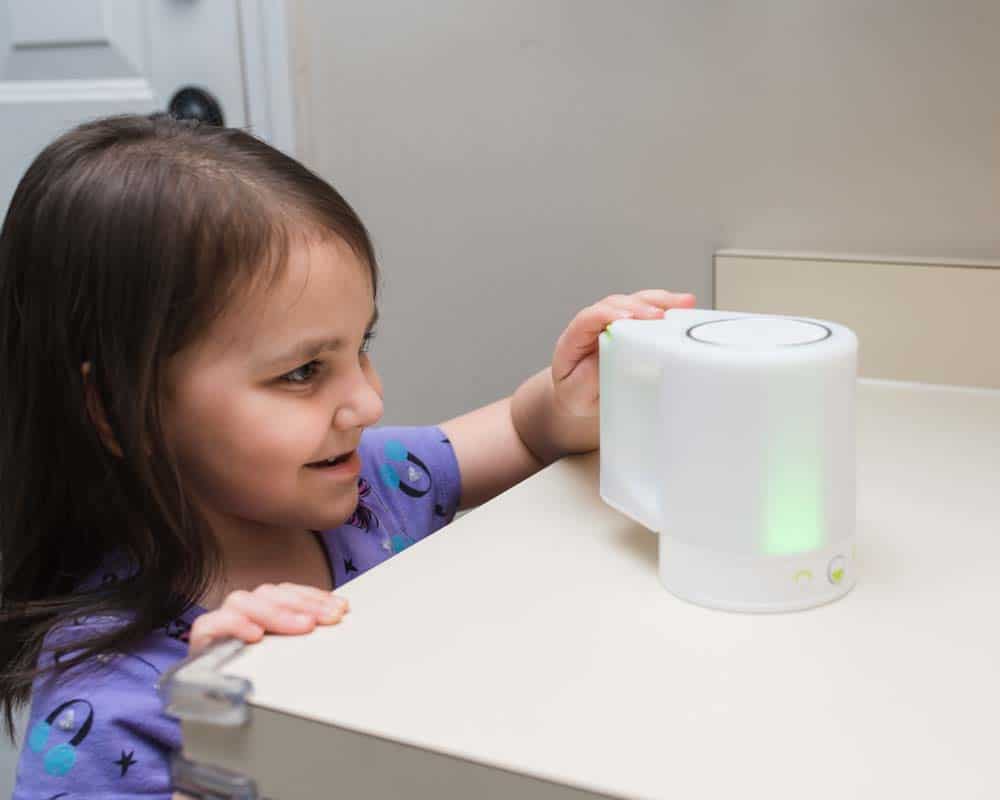
The very first day, my daughter was super excited to use Goodtimer. She reminded me often that she was “having a good day” and her eyes widened every time the Goodtimer chimed and a new segment lit up.
That day was a dream. Wow, this thing is working pretty good, I thought. I wondered how long before the novelty wore off.
Managing undesirable behaviors
The next day was just as good as the first. All through the weekend, my kids were angels. I couldn’t believe how good I felt just from not fussing at my children all day every day! I even adjusted our reward chart to include more rewards because my daughter was earning tokens faster than I even expected.
Then it happened. My child stopped listening to her parents and we had to turn Goodtimer over.
You would’ve thought her world ended.
She understood that she made a poor choice. And luckily for me, my kid isn’t super naughty as it is. She just doesn’t always listen. After a couple minutes, she decided to show her good behavior again and we turned Goodtimer back over. All was right in her world again.
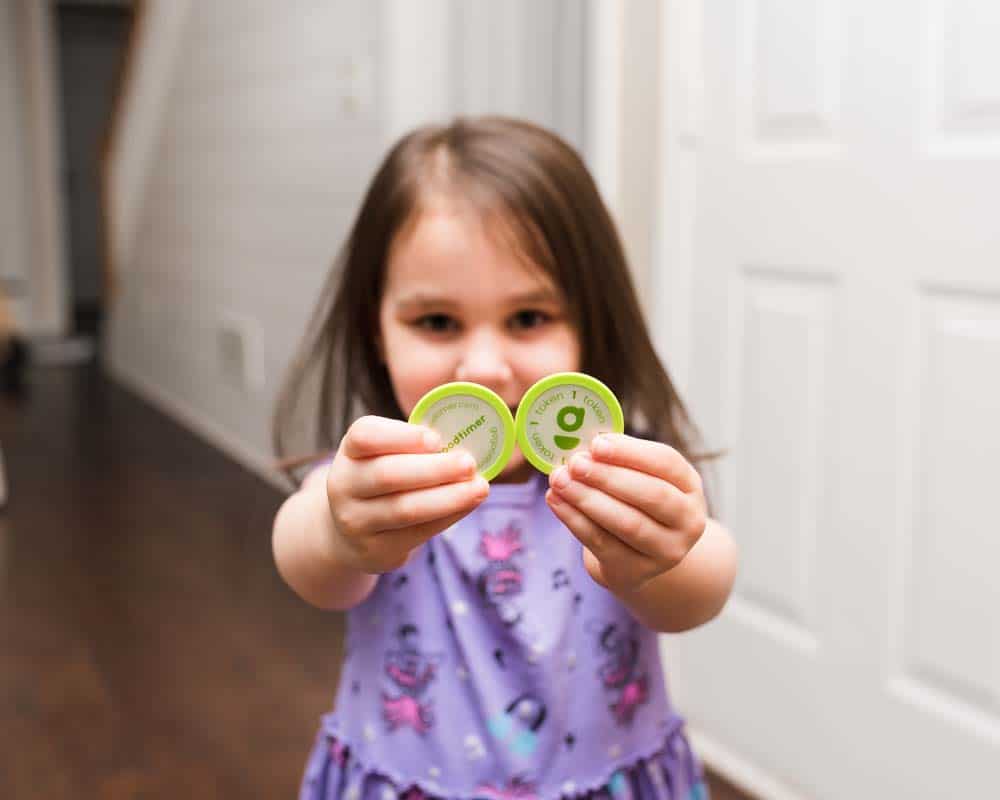
No yelling from me. No threats or timeouts. I didn’t feel bad at all. She was sad but she also knew she was in control. She was able to have both visual and verbal reminders of her behavior status, and encouragement when she got back on track.
It was quite honestly one of the most pleasant “consequences” I have ever had to experience with my children.
Recommendations for other parents
With so many parents considering homeschooling or virtual learning this next school year, I can see Goodtimer being very effective for elementary age students. Stay on task – Goodtimer stays upright. Get off task, whine about your work, or refuse to work – Goodtimer turns over. There could even be a brief brain break after each segment lights up.
Goodtimer is intended to be used by one child, so if you have multiple children you would use a different device for each child. In our family, I only need it for my 2 and 3 year olds, and right now my 2 year old is really too young to understand it. So for now, we only have one device. However, he is learning and he already responds to both the positive encouragement from Goodtimer as well as the negative association with turning Goodtimer over.
While my 2 year old doesn’t officially earn Goodtimer tokens for good behavior, I occasionally reward him with a free token so that he feels included. Especially if he eats his dinner or wears his socks without a struggle!
Printable Reward Chart
While it’s recommended that your family create your reward chart together, I wanted to share our family’s chart if you need help with some ideas. These tangible incentives won’t work for everyone, but right now they do work for us!
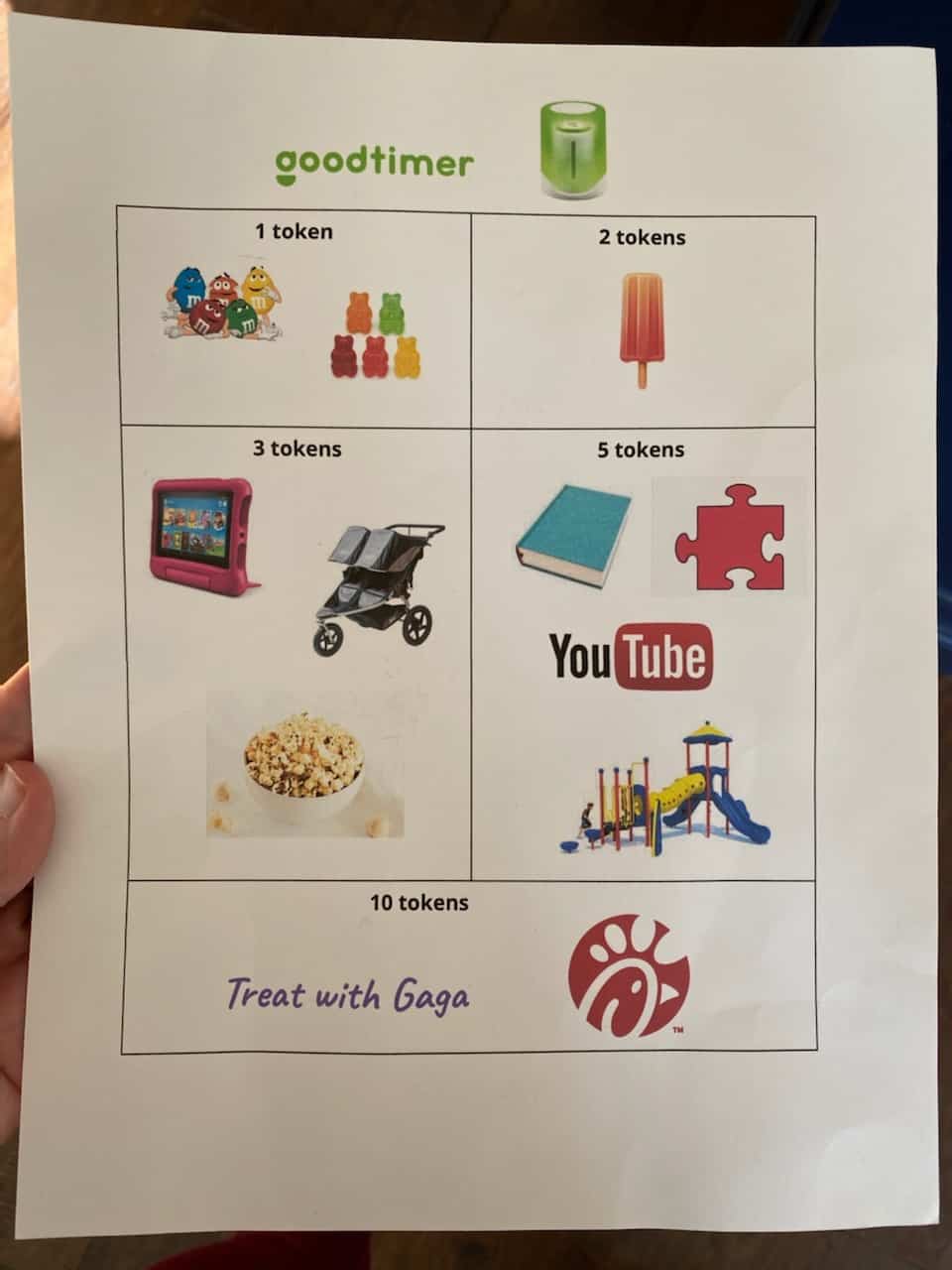
You can access a blank copy of our reward chart here – just copy and save to your Google drive. Then you can print the blank chart and fill it in, or find photos online that show images of your reward options and customize the chart for your family. Visuals are especially effective for younger children who haven’t yet learned to read!
Q&A with Adam Ashley, creator of Goodtimer
I had the opportunity to have a virtual interview with Adam Ashley, the parent and creator of Goodtimer. Here’s our question and answer session:
What sparked your creation of Goodtimer?
When our oldest son Peyton was first born, it was tough, but being a parent was all about just keeping them alive – making sure he was eating, sleeping, and going to his regular doctors’ appointments. Around the time he turned two, we realized it was also our job to start teaching him good habits and address the temper tantrums and power struggles. Later, when our youngest son Everett turned three, sibling rivalry started to be a big challenge for us.
At first, when our kids misbehaved, we wanted to make sure there were “consequences,” after all, our parents grounded us when we misbehaved, and we turned out okay…right? After a lot of trial and error, we were frustrated to learn that yelling and putting our kids in timeout didn’t work, and at the end of the day, we hated feeling like the “bad guys.” Like many frustrated parents, we turned to the experts. Through our research, we discovered Positive Parenting and started using positive parenting methods in our home, but we couldn’t find an approach that was easy to incorporate into our routine and one that our kids were excited about.
Around the time my youngest son was three, we asked the question, “What if we created a game for the whole family where our kids could win at making good choices?” Another way we thought about it was, what if we had an easy and useful tool that would motivate good behavior in a way that is opposite to a “timeout” punishing unwanted behavior?
We developed a concept for a game that encouraged and measured ‘Good Time’ and was engaging for young kids that would light up and make positive sounds when they demonstrated desired behaviors and dispensing physical tokens that they could exchange for the things they wanted.
What kinds of research or proven behavioral methods did you reference when creating this tool?
When we first started working on Goodtimer, we discovered Positive Parenting, which leading experts recognize as the most healthy and effective method to improve child behavior. I love this quote from Pam Leo of Connection Parenting, which sums in two sentences what Positive Parenting means to me. “You can’t teach children to behave better by making them feel worse. When children feel better, they behave better.”
Decades of research by behavioral psychologists and parenting experts have proven that children learn best when they understand expectations, can keep them in mind, and receive consistent positive reinforcement when they make good choices. Furthermore, when parents respond negatively to undesired behaviors by yelling or punishing, our children are more likely to continue to do the things we don’t want them to do. In other words, kids are more likely to repeat the behaviors that we give attention to.
Once we had developed the concept for Goodtimer, we partnered with positive parenting experts, including Jackie Insinger, a motivation and communication expert and a nationally acclaimed family dynamics coach. We worked with Jackie and other parenting experts to develop Goodtimer to embody positive parenting methods into one comprehensive and easy to use a product that would help families encourage their kids to form good habits that last.
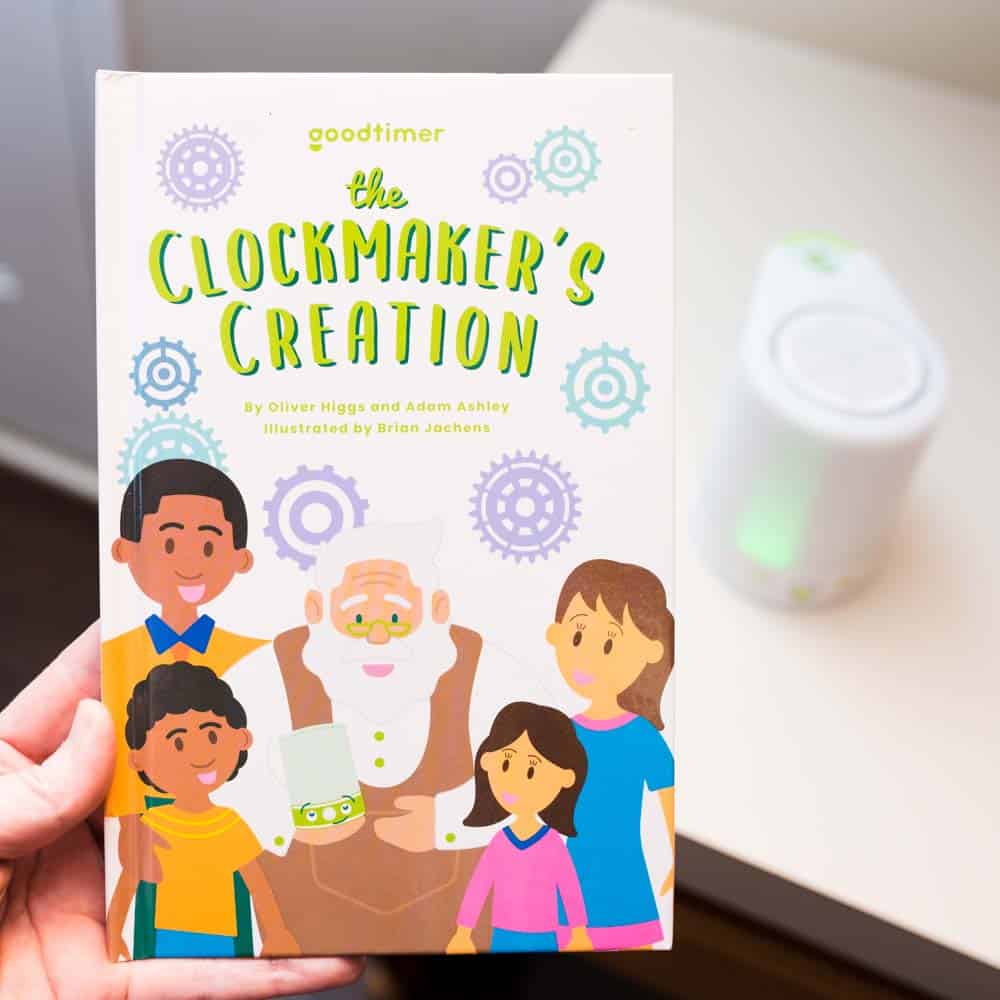
A lot of parents use a behavior chart for their kids or some sort of point system for rewards. How is Goodtimer different – or even better than those systems?
We often describe Goodtimer as a modern take on the traditional behavior chart. When we first discovered positive parenting, we read a lot about behavior charts, and we even tried using them. Traditional behavior charts have been used for years to define expectations and positively reinforce good behavior. Although they are a good tool, there are several drawbacks to behavior charts.
In our experience, behavior charts are antiquated. It’s the 21st century where the majority of kids are growing up in a world of smartphones, tablets, and high-tech educational toys. Traditional chore charts aren’t interactive, engaging, or portable, and they require parents to do a lot of work. As parents ourselves, life is hectic, and we would often forget to do the chore chart routine at the end of the day. As a result, our kids would feel less motivated because they did the work, but didn’t receive the positive reinforcement they expected.
In other words, chore charts are a chore for parents, and if you forget to use them, they stop being effective for kids. We also found that chore charts don’t provide interactive, real-time feedback when you are trying to address behavior issues at the moment.
Goodtimer is different because it belongs to your child, and they are responsible for their performance. As your child interacts with their Goodtimer throughout the day, they continue to remain motivated because they clearly understand how their behavior impacts their performance.
Finally, Goodtimer is a glowing, talking, portable reminder for kids to keep at it providing positive reinforcement day and night, and parents don’t have to keep track of rewarding good choices because Goodtimer keeps track of it for you.
So far, I’ve seen plenty of benefits to Goodtimer, and it seems to be effective for many families. Have you encountered any drawbacks or potential flaws with the Goodtimer?
We haven’t encountered any ‘drawbacks or flaws’ to Goodtimer, but we believe there is always room for improvement. I think it’s important to note that more than two years of research and development, including two consumer trials went into Goodtimer before launch to ensure that it would be a safe and effective tool for families.
We’re very proud of the overwhelmingly positive feedback that we have received from Goodtimer families who are raving about how Goodtimer has made a positive impact on their lives. Also, we are listening and actively working on ways to improve Goodtimer so that it is an even more effective tool for families in the future. I’m a firm believer that there is always room for improvement, and we’re actively working on Goodtimer product updates and new products to help families achieve more peace at home and a more connected family experience.
You have a list of suggested rewards on the Goodtimer website, and I have seen ideas shared in your Facebook community as well. I have to ask, though – what are some “out of the box” rewards that your family or other families have used? I know some parents need novel ideas for behavior rewards after a while!
At Goodtimer, we believe strongly that every family needs to do what works for them, and this is perhaps the most important factor when creating your family’s token list. When we talk to Goodtimer families who ask for recommendations for their token list, we recommend that they ask their kids what they want to exchange tokens for. This is important because if the kids are working towards a goal that is important to them, they’re naturally going to be more motivated to make good choices to earn Good Time.
I like it when families have told us that their kids want to save for ‘big ticket’ items. Delayed gratification is a tough concept for some kids to learn, but I think it’s an important life lesson. We all have to work towards the things that are important to use, and there’s a real feeling of accomplishment that occurs when you set a challenging goal, work towards it, and achieve it.
I remember one family told us that their kids wanted to save up to go on a day trip to an amusement park. The tickets were expensive, but the parents did the math and came up with a fair number of tokens to achieve the goal. It probably took the kids a month or more of saving, but then the kids got this enormous feeling of pride to trade their tokens in to “buy” a family adventure that created new memories and brought the family closer together. I love this idea because the kids get to do something nice for their family.
Recently, my son wanted a Macbook laptop. It wasn’t in the budget, but he asked if he could save his tokens and exchange them for cash. We did the math, set a goal, and a few months later, he had earned enough tokens to pay for half of the laptop. We paid for the other half. It was a great experience for him, and now he values it more because he understands how much hard work was required to get the thing that was important to him.
Are there any other resources – books, websites, apps, etc. – that you would recommend to parents who may want additional support with parenting topics?
There are so many great positive parenting resources out there (too many to name) but here are some books I’ve read that stand out and a few sites that I subscribe to that are great supplemental resources for Goodtimer:
Books:
- Parenting with Love and Logic (Cline & Fay, 2006) <– (highly recommended by Amanda too!)
- If I Have to Tell You One More Time (McCready, 2012)
- Positive Discipline (Nelson, 2006)
- Peaceful Parent, Happy Kids (Markham, 2012)
- The Positive Parenting Workbook (Eanes, 2018)
Websites:
Additional information about positive parenting principles:
Leading research shows, the most effective way to encourage our children to continue to make good choices is to give attention and positive reinforcement to good behavior when it occurs. When children receive positive reinforcement for good behavior, it improves their self-esteem, motivating them to continue to make good choices.
In contrast, when we respond to negative behaviors by yelling at our kids or punishing them, the opposite occurs. When punished, children lose confidence because they often feel that the negative reinforcement is directed at them, not just the behavior.
Unlike punishing bad behavior with timeouts, Goodtimer places the focuses on your child’s positive behavior, encouraging them to continue to make good choices throughout the day.
Establish Clear Expectations
Research shows that for children to form new habits, they need to clearly understand expectations and keep them in mind throughout the day. Kids are expected to follow a lot of rules, and it’s often difficult for them to remember everything that is expected of them. Therefore, kids thrive in environments with structure, consistency, and clearly defined expectations.
Goodtimer is the first product of its kind that provides a consistent and stimulating reminder for kids to stay on task and meet expectations. The Goodtimer Children’s book allows the family to create the “house rules” that are consistent with their values, and Goodtimer’s patented approach provides positive reinforcement to remind children to continue to make choices throughout the day.
Provide Meaningful Recognition for Good Choices
Research shows that the most effective way to reinforce good behavior is to recognize the behavior when it occurs with a meaningful incentive. Research also shows that the misuse of “rewards” often results in children who feel entitled to receive a reward for every good deed.
Goodtimer is the first universal positive reinforcement tool encouraging children to make good choices throughout the day. Over time, children earn Goodtimer tokens for consistent good behavior rather than as a reward for a discrete behavior. The Goodtimer children’s book allows the family to establish an incentive system that is consistent with their values allowing the children to exchange tokens for things that they’re excited about and that you approve of.
With consistent positive reinforcement and meaningful incentives, Goodtimer provides a framework for success that has been proven to encourage children to form good habits that last.

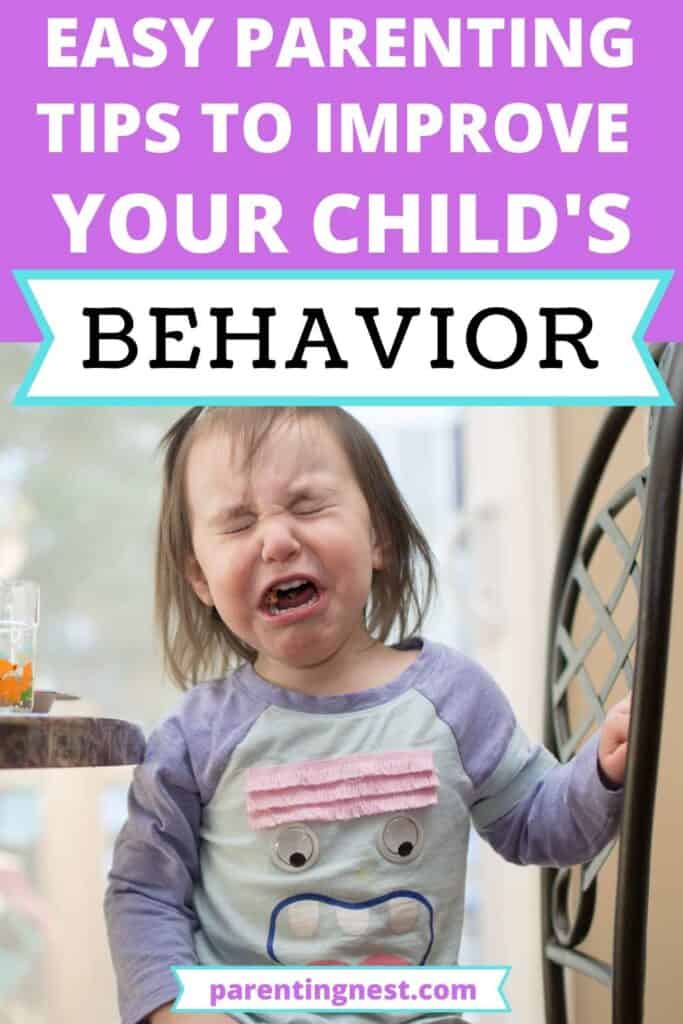

MEET THE AUTHOR
Amanda
As a mom of 4 kids (and the oldest of 4 kids herself), Amanda has over 30 years of parenting experience. A former special education teacher, Amanda has a Master’s degree in Special Education and a second M. Ed. in Educational Leadership.
When she’s not working, Amanda enjoys DIY projects, exercising, photography, and long walks through Target.
You can find Amanda on all social media at @parentingnestblog and @amandaseghetti

